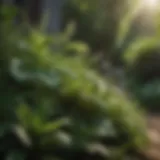Effective Strategies for Chigger Prevention in Yards
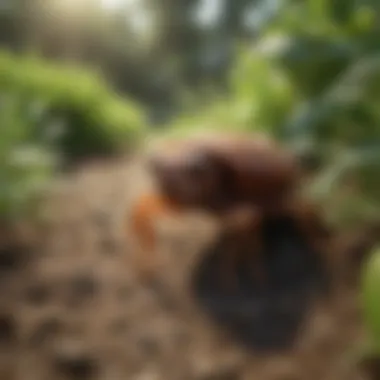

Preventive Pest Control Strategies
When it comes to maintaining a beautiful yard, preventing chiggers is not just a task but a commitment. With the right strategies, you can turn your outdoor space into a sanctuary rather than a battleground against these pesky pests. Let’s delve into some foundational approaches that form the bedrock of effective pest control.
House Exterior Protection
The outer defenses of your home play a crucial role in keeping chiggers at bay. It’s about setting up a barrier that not only repels these nuisances but also protects your living space.
Tips for sealing cracks
Start with inspecting your home's exterior for cracks or gaps. These openings can act as portals for chiggers and other bugs. Seal these crevices using caulk or other appropriate materials. This simple yet efficient task can save you a headache down the road.
Clearing debris
Keep the space around your home tidy. High grass, piles of leaves, and cluttered areas provide the ideal habitat for chiggers. Regularly rake and remove debris, especially in areas where moisture tends to accumulate. Keeping things neat not only helps your yard look pristine but also deters these unwelcome guests.
Preventing pests from entering
Install door sweeps and screen doors to prevent chiggers and other insects from slipping in unnoticed. A thorough inspection of window screens can also go a long way in safeguarding your indoor space from potential invaders.
Yard Maintenance
A well-maintained yard can be a fortress against chiggers. Establishing an essential routine is your best line of defense.
Essential yard care routines
Mow your lawn regularly to keep the grass low. Chiggers thrive in tall grass, so keeping it trimmed means denying them their favorite hiding spots. Also, watering your garden during early hours reduces damp conditions in the evening when chiggers are most active.
Methods for keeping yard pest-free
Consider planting resistant plants or using gravel pathways to decrease the available habitat for chiggers. Adding mulch can also help deter these pests by creating a barrier around your plants and soil.
Indoor Cleanliness
Although we focus on the yard, keeping your home clean is equally critical, as it creates a buffer against pests trying to find refuge indoors.
Expert cleaning tips and techniques
Regularly vacuuming carpets and upholstery can help pick up any stray critters. Take special care to clean under furniture and in corners, as these are prime nesting sites.
Maintaining a pest-resistant indoor environment
Make a habit of inspecting your indoor plants and ensuring that soil remains dry, as moist soil can attract pests. Remember, a clean home contributes to a pest-free environment.
Garbage Disposal
Waste management isn’t just a chore; it’s a crucial factor in pest prevention.
Efficient waste disposal methods
Invest in good-quality containers with tight-fitting lids to keep food waste securely contained. Ensure that you dispose of garbage regularly to avoid attracting pests.
Importance of proper garbage disposal
Proper disposal not only keeps your yard clean but also prevents chiggers from being lured to your property through food remnants or scraps.
Other Pest Prevention Strategies
Diverse strategies stem from innovative thinking. In pest control, creativity can yield fruitful results.
Innovative ways to safeguard your home
Consider introducing natural predators into your environment. Birds, for example, can be incredible allies in keeping pest populations at bay. Installing birdhouses or feeders encourages their presence without upsetting the local ecosystem.
Moreover, adding barriers such as fences or netting can deter larger pests while promoting a chigger-free landscape. Addressing the problem from multiple angles can provide the strongest defense against unwanted invasions.
"An ounce of prevention is worth a pound of cure." — This ring true when it comes to pest control, highlighting the value of proactive measures.
By implementing these preventive pest control strategies, you’re not just managing chiggers; you’re creating a harmonious outdoor living space. With diligence and thoughtfulness, we can ensure that our yards remain safe and inviting for our families.
Next, we will explore the importance of identifying pest risk areas in your yard.
Understanding Chiggers
Chiggers, often overlooked, are tiny arachnids that can transform a pleasant day outdoors into a troublesome experience. Understanding chiggers is not just about identifying them; it’s about recognizing the impact they can have on your yard and your family. By exploring several fundamental aspects regarding these pests, homeowners can better strategize to keep their yards chigger-free.
Knowing the biology and life cycle of chiggers helps in pinpointing when they are most active and when they might become a nuisance. Not only does this knowledge inform homeowners about the best times for preventative measures, but it also emphasizes the importance of maintaining an environment less conducive to chigger habitation.
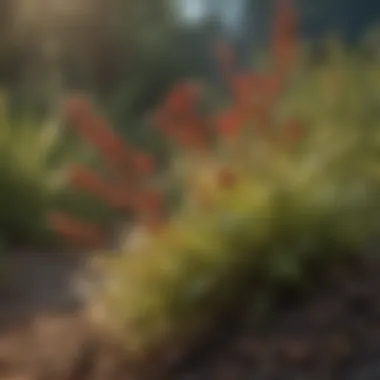

Moreover, identifying chigger infestations early can save time and hassle. Spotting signs of infestation can lead to timely interventions, preventing larger problems down the line. This can also help in planning landscaping or maintenance routines that differ according to the behavioral patterns and habitats preferred by chiggers. A well-made plan markedly reduces the likelihood of having your outdoor spaces invaded by these bothersome critters.
"An ounce of prevention is worth a pound of cure." Understanding chiggers can indeed serve as that crucial ounce of prevention.
A solid grasp of these elements not only benefits homeowners' outdoor living experiences but also enhances the safety of their families during backyard activities. It's essential to gain insights from this segment to ensure a thriving, pleasant yard—one that is free from the disruptions caused by chiggers.
Biology and Life Cycle of Chiggers
Chiggers belong to the family Trombiculidae, and their life cycle consists of four main stages: egg, larva, nymph, and adult. They start their life as eggs, which hatch into larvae. These larvae are particularly troublesome. Their primary food source is the skin of mammals, including humans. Once they latch onto a host, they begin feeding within hours, which is when they can cause intense itching and discomfort.
The larvae eventually drop off to grow into nymphs and then adults, progressing through different environments. Each stage of their life cycle requires different conditions, which is critical to understand for preventing chigger infestations in your yard.
Identifying Chigger Infestations
Spotting chigger infestations can be tricky, primarily because these pests are tiny—often less than a millimeter in size. Here are some effective ways for homeowners to identify their presence:
- Skin Reactions: If you or your family members experience itchy, red spots following outdoor activities, it could signal a chigger encounter. These bites are generally small, raised welts that can appear in clusters.
- Area Inspection: Check grassy areas, especially near the edges, under shrubs, and around tall grasses where chiggers like to dwell. If you notice excessive crawling insects in these areas, it might indicate chigger activity.
Proactively monitoring these signs can save you future headaches, making it vital for those who enjoy spending time outdoors.
Behavioral Patterns and Habitats
Chiggers thrive in warm, humid conditions, making them more prevalent during late spring to early fall. They're often found in areas with dense vegetation or debris. While they don't jump or fly, they crawl quite adeptly, typically existing just a few inches off the ground. Understanding their habitat acts like a roadmap for effective prevention strategies.
They prefer the shade of shrubs, woodlands, or tall grasses, so keeping such spots tidy is crucial:
- Regular Cutting: Keep grass short, ideally under three inches, where they’re less likely to thrive.
- Minimizing Leaf Litter: Regularly rake up leaves, cuttings, and other debris—this removes potential habitats for chiggers.
By considering these behavioral patterns and refining outdoor practices accordingly, homeowners will gain more control over their yard’s ecosystem, thereby discouraging chigger populations from taking root.
Assessing Your Yard
Assessing your yard is a vital step toward keeping it chigger-free. You can't just sit back and hope for the best; you need to actively look at your space, understand its vulnerabilities, and make necessary changes. This proactive approach lessens the chances of an infestation and promotes a healthier environment for all who use the space.
Evaluating the Environment
To effectively assess your yard, you start with evaluating the environment surrounding it. Look around you: is your yard a haven for lush vegetation or is it mostly bare dirt? Chiggers thrive in warm, moist environments, typically hidden in tall grass, weeds, and brush. Here are a few key points to consider:
- Soil Moisture: Chiggers prefer a humid atmosphere. If you have areas in your yard that are waterlogged or tend to hold moisture, you might want to rethink their use. Creating proper drainage can help dry out those low spots.
- Vegetation Type: The type of plants in your yard can also affect its chigger risk. Some dense, bushy types can provide a perfect hiding place for these pests. Native flowering plants are wonderful for aesthetics, but they sometimes invite chiggers too if not managed well.
- Sunlight Exposure: Chiggers tend to stay in shady spots during hot days. If your yard has plenty of shade, you may want to consider how to balance sunlight and shaded areas.
Regularly checking the moisture levels and considering the surrounding plant life will ensure that you can adjust your landscaping practices accordingly.
Identifying Potential Problem Areas
Once you've evaluated the environment, the next step is identifying potential problem areas. Chiggers love particular habitats, and recognizing these spots can save you a lot of trouble in the long run.
- Tall Grass and Weeds: If you have sections of tall grass or dense weeds, it's like rolling out a welcome mat for chiggers. Mow regularly, and keep the undergrowth in check. This way, you reduce their breeding grounds significantly.
- Leaf Piles and Debris: Piles of leaves or other organic debris provide excellent cover for chiggers. Make it a habit to clear out leaf litter, particularly in the fall. A clean yard can deter these pests from calling it home.
- Wood Piles: Stacks of firewood or lumber can inadvertently create a comfy home for chiggers. Try moving them away from the yard's edges and keeping them raised off the ground when possible.
By addressing these key areas in your yard, you're nipping the problem in the bud. A more thorough and careful assessment leads to a noticeable difference in controlling chigger populations.
Landscaping Practices
Landscaping practices play a crucial role in preventing chiggers in your yard. When you think about landscaping, it’s not just about aesthetics, but also about creating an environment that is inhospitable to these pests. Chiggers thrive in specific conditions—underbrush and tall grass provide ideal habitats for them. By carefully planning your yard's layout and selecting appropriate features, you can significantly reduce the chances of a chigger infestation.
Effective landscaping involves a blend of strategic design and ecological understanding. For example, open and sunny areas deter chiggers, as they prefer shaded and humid spots. Consider incorporating zones in your yard that promote better airflow and sunlight exposure. This does not only help in keeping chiggers at bay, but also encourages other beneficial insects to flourish. Moreover, a well-planned garden tends to need less maintenance, resulting in reduced clutter and debris that can attract these pests.
Designing a Chigger-Resistant Yard
Designing a chigger-resistant yard starts with recognizing the conditions that chiggers favor. To tackle this, start by keeping grass closely mowed and bushes trimmed. A manicured yard looks appealing and sends a strong message to these pests—it's not a welcoming place.
Here are some guidelines to create an effective design:
- Tiered Planting: Having different layers can help break up ideal habitats for chiggers. Taller plants shade the areas beneath, reducing humidity while making it less favorable for chiggers.
- Pathways and Borders: Creating clearly defined paths, whether using gravel or wood chips, helps segregate areas. This not only adds beauty but also keeps people and pets out of the chigger-prone zones.
- Natural Barriers: Use non-pesticidal methods such as mulching with cedar shavings. These not only look great but can help repel pests. Additionally, opting for coarse ground cover can reduce the prevalence of grass, which chiggers tend to favor.
A thoughtful design can transform your outdoor space not just for aesthetics, but also as a strong line of defense against chiggers.
Choosing Effective Plants
Selecting the right plants for your landscape is paramount in discouraging chigger populations. Certain plants inherently deter pests due to their properties, while others can attract beneficial insects that can regulate pests in your yard.
- Avoid Dense Vegetation: Chiggers are more likely to infest areas with dense foliage. Thus, choose plants that are spaced adequately to allow air circulation. This can reduce humidity levels that chiggers find comfortable.
- Repellent Plants: Consider incorporating plants known for their natural pest-repellent properties such as marigolds or citronella grass. These don’t just beautify your garden, they also work against these life-crushing critters.
- Native Plants: Opt for native species that are well-adapted to your local environment. They often require less maintenance and are more resilient against pests without the need for pesticides.
By carefully choosing the plants you cultivate in your yard, you can foster a chigger-resistant environment while enjoying the native beauty of your area.
A well-designed landscape, along with strategically chosen plants, creates a dual defense against chiggers—keeping them at bay while enhancing the natural beauty of your yard.
Regular Maintenance Strategies


Regular maintenance is a cornerstone of an effective strategy for preventing chiggers in your yard. By consistently tending to your outdoor space, you not only keep it visually appealing, but also minimize the conditions that favor chigger populations. These tiny pests thrive in environments that are neglected, where overgrown grass and litter create ideal hiding spots. Thus, establishing a routine for lawn care and debris removal is vital in your defense against these mites.
Mowing and Lawn Care Techniques
Mowing your lawn isn't just about keeping up appearances. Regular mowing helps reduce the height of grass, which is essential because chiggers are more prevalent in tall grasses and weedy areas. Cutting grass to about two to three inches can disrupt their habitat and deter them from settling in your yard.
Moreover, using sharp mower blades is important. Dull blades tear the grass rather than cut it cleanly, creating open wounds susceptible to diseases and encouraging the growth of undesirable plants that can attract chiggers.
- Frequency: Aim to mow at least once a week during growing seasons.
- Grass Types: Different types of grass may require specific mowing techniques, and understanding your local flora can go a long way.
Implementing these simple mowing techniques can make a noticeable difference in your landscape and deter chigger infestations.
Managing Leaf Litter and Debris
In addition to regular mowing, keeping your yard free of leaves, twigs, and other debris is crucial. Chiggers love to hide in the moist, sheltered environments created by leaf litter. By managing this debris, you create a hostile environment for them to thrive.
Here's how you can manage leaf litter effectively:
- Raking: Make it a routine to rake leaves, especially in the fall when they accumulate. Remove clumps of debris that can harbor not just chiggers but other pests too.
- Composting: Instead of just piling leaves in a corner, use a compost bin to break down organic matter. This not only benefits the environment but gives you nutrient-rich soil.
- Regular Cleanup: Try to have a designated cleanup day each month, where you check for and remove any unwanted debris.
Water Management and Drainage
Water management is another critical aspect that cannot be overlooked. Standing water is often a magnet for pests, including chiggers. Monitoring your drainage and ensuring that water is moving away from your lawn will lower the likelihood of mosquito populations, which often coexist with chiggers.
Consider implementing the following strategies:
- Check Gutters: Regularly clean gutters to prevent water from pooling.
- Install Drainage Systems: If you have areas prone to standing water, consider adding drainage solutions like French drains or dry wells.
- Adjust Sprinkler Systems: Overwatering can be a problem. Make sure your sprinkler system is efficient and not causing water to collect in puddles around your yard.
Key Takeaway: Maintaining a well-groomed yard through mowing, managing debris, and ensuring proper drainage creates an uninviting environment for chiggers.
By adopting these regular maintenance strategies, your yard stands a much better chance against chigger infestations. Keep in mind that a little effort goes a long way. Your outdoor space not only becomes more enjoyable for your family but also a safer haven against these pests.
Chemical Methods of Control
When it comes to safeguarding your yard against those pesky chiggers, chemical methods of control can play a pivotal role. While many homeowners prefer natural remedies, understanding how and when to use pesticides can be the key to creating a truly chigger-free environment. It’s not just about tossing some chemicals around and hoping for the best; it involves an informed, methodical approach that considers both efficacy and safety.
Understanding Pesticides
In the world of pest control, pesticides come in various forms, each tailored for specific situations. There are two primary categories:
- Insecticides: These target a broad range of insects, including chiggers. They work by disrupting vital biochemical processes.
- Repellents: These create a barrier that deters pests from entering treated areas.
Using pesticides requires an informed understanding. Some contain active ingredients that may fit different scenarios, so it’s essential to read labels thoroughly. Not only do you need to recognize what each pesticide is meant to do, but also how it affects the environment and any unintended consequences it might bring.
Choosing the Right Pesticide
Selecting the appropriate pesticide is crucial. You can't just grab any bottle from the shelf and hope for the best. Here are some considerations:
- Active Ingredients: Look for products with ingredients like permethrin or bifenthrin, known to effectively eliminate chiggers.
- Formulation Type: Sprays, granules, and foggers all have different applications. Granules are often used for lawns, while sprays can target foliage directly.
- Environmental Impact: Consider eco-friendly options. Some pesticides are designed to minimize their effects on non-target species and the surrounding environment.
Research is your ally here, and local extension services can provide targeted advice based on your area's specific needs.
Application Techniques and Safety
Proper application is part and parcel of effective pest control. A well-laid plan ensures your efforts don’t go awry. Here’s how you can approach this:
- Timing: Apply pesticides during dry weather; rain can wash away treatments, reducing effectiveness.
- Targeted Application: Concentrate on known pest habitats. Chiggers typically dwell in grassy or weedy areas, so focus your efforts there.
- Protective Gear: Always wear gloves, masks, and goggles. Nothing spoils your day like unnecessary exposure to chemicals.
"Safety always comes first! A few precautions can prevent issues down the road."
Natural Remedies and Non-Chemical Approaches
When it comes to battling chiggers, many homeowners are keen to adopt methods that are less chemical-dependent. Natural remedies and non-chemical approaches hold great importance in developing a balanced ecosystem in your yard while effectively keeping these pesky pests at bay. These strategies not only minimize exposure to harmful substances but also promote a healthier outdoor environment. Moreover, enlisting nature’s help can lead to sustainable long-term solutions for chigger control.
Essential Oils and Natural Repellents
Essential oils are gaining traction as natural repellents against chiggers. Some of the most effective oils include cedarwood, peppermint, and tea tree oil. When used properly, these potent oils can provide significant deterrent effects. For instance, a mixture of cedarwood oil and vinegar sprayed around vulnerable areas tends to repel not just chiggers but also other unwanted insects.
Here’s how you can create your own natural repellent:
- Combine 10-15 drops of essential oil with a cup of water in a spray bottle.
- For added strength, mix in a tablespoon of witch hazel.
- Shake well before each use and apply generously around the areas of your yard where chiggers are known to be active.
Using essential oils is generally safe for the environment and offers a pleasant aroma in your yard. However, it’s wise to test a small area first to ensure that your plants won't react negatively.
Beneficial Insects and Natural Predators
Another natural method to control chigger populations involves encouraging beneficial insects and natural predators. It may sound surprising, but creatures like ladybugs, lacewings, and the humble praying mantis play a vital role. These insects help maintain the balance within your yard's ecosystem by preying on smaller pests, reducing the likelihood of chigger infestations.
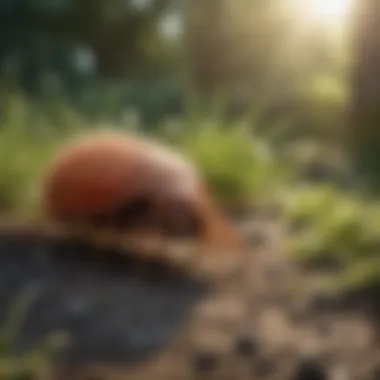
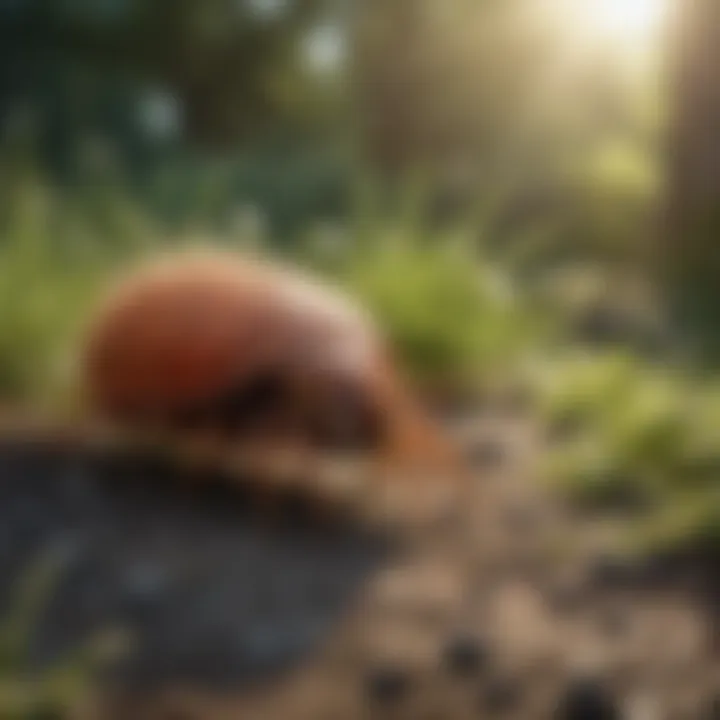
To foster a friendly environment for these natural allies, consider these strategies:
- Plant diverse flora: Incorporate a variety of plants, especially flowering ones, which attract beneficial insects into your yard.
- Create habitats: Install small bugs hotels or leave areas of undisturbed vegetation that provide shelter and nesting spots.
- Avoid broad-spectrum insecticides: These chemicals can wipe out good insects alongside problematic ones, so opt for targeted solutions when necessary.
By supporting beneficial insect populations, you can not only keep chiggers in check but also foster resilience within your yard’s overall ecosystem.
"Natural solutions can lead you towards a healthier, happier outdoor environment."
Embracing these non-chemical methods promotes not only a chigger-free yard but a thriving habitat for plants and wildlife alike.
Preventive Measures for Outdoor Activities
Taking precautions during outdoor activities plays a significant role in keeping your yard chigger-free. These measures not only add a layer of protection for you and your family but also minimize the risk of chigger infestations in your outdoor space. Consider this: spending time in your yard can be enjoyable and relaxing, but it's crucial to ensure that you don't unknowingly bring home unwanted pests.
Clothing and Gear Considerations
When heading out into your yard, choices in clothing and gear can make a tangible difference. Wearing light-colored, long-sleeved shirts and long pants helps you spot chiggers easily, as they are more visible against a lighter background. If possible, treat your clothing with permethrin, an insect repellent designed specifically for fabrics—it’s a game changer. Remember, it’s not just about what you wear; the right gear is equally important.
- Footwear: Opt for closed-toe shoes instead of sandals. This provides a barrier against potential chigger bites. High socks can be your best buddy too—tuck your pants into them to prevent chiggers from crawling up your legs.
- Accessories: Hats and sunglasses not only shield you from the sun but can serve as an extra layer of protection against these tiny mites.
Being mindful of your clothing and gear can significantly enhance your defense against chiggers.
Post-Activity Yard Checks
After enjoying a day outside, it's essential to conduct a thorough sweep of yourself and your belongings before heading back indoors. This might seem tedious, but it pays off in spades. Chiggers can latch onto clothing and skin, and doing a quick inspection can help mitigate this issue. Here are some steps to follow:
- Inspect Your Clothes: Take a few moments to check your attire for any signs of chiggers. Concentrate around seams and folds where these critters like to hide.
- Shower Promptly: Once you're done with your outdoor escapade, hop in the shower. A good wash can help remove any chiggers that might’ve hitched a ride on your skin. Don't forget to use soap and scrub your body well, paying extra attention to crevices.
- Clean Your Gear: Don’t overlook your personal items. Shake out backpacks, hats, and outdoor gear before bringing them inside. Leaving these unchecked allows chiggers to take residence in your home.
Keeping an eye out for chiggers after outdoor activities reduces the likelihood of bringing them into your living space. As with many other nuisances, prevention is always better than cure.
Educating Your Family and Guests
Educating your family and guests about chiggers stands as one of the most effective strategies to ensure a chigger-free environment in your yard. Knowledge is power, especially when it comes to preventing discomfort caused by these tiny pests. By instilling awareness, you not only enhance their understanding of these creatures but also empower them with practices that contribute to a safer and more enjoyable outdoor experience.
It’s crucial to highlight how awareness can turn preventable situations into mindful actions. From recognizing how chiggers operate to understanding their preferred habitats, sharing this information makes everyone a proactive participant in your yard maintenance efforts. This alignment fosters a sense of responsibility among your family and guests, making them vigilant during outdoor activities.
Instilling Awareness About Chiggers
To start, ensuring that everyone understands what chiggers are is paramount. Chiggers, though minuscule, can turn a pleasant outdoor experience into an itchy nightmare. Explain that these larvae from the Trombiculidae family are typically found in grassy and wooded areas, and they prefer moist, warm spots. When guests engage with nature in your yard, a simple conversation can help them recognize these nuisances by describing their life cycle and behavior.
Consider using visual aids or a simple infographic that illustrates where chiggers commonly reside and how they feed. Discussing this knowledge will enable your family and guests to be more cautious during activities such as picnics, gardening, or just lounging in the sun.
Key elements to cover include:
- Physical Characteristics: How to identify chiggers visually – tiny, red-yellow larvae.
- Behavior: They tend to climb onto the skin rather than flying or jumping.
- Habitat Preferences: Emphasizing areas like tall grasses and heavily mulched spots where chiggers are fond of living.
This educational approach also allows you to share the discomfort associated with chigger bites, which often leads to intense itching after the larvae feed. By painting a clear picture of the implications of a chigger bite, your family and guests will be more likely to take preventive measures seriously.
Creating a Safe Outdoor Environment
Once awareness is instilled, the next step is to forge a safe outdoor environment that minimizes the risk of chigger encounters. Creating this safe haven might involve a few changes and cooperative efforts from everyone.
- Shared Responsibility in Yard Maintenance: Foster an environment where everyone participates in yard upkeep. Regular mowing and clearing out leaf litter help ensure that your yard does not become a chigger haven.
- Designated Play and Relaxation Areas: Set up specific zones for activities, ensuring these areas are well-maintained and less prone to chigger infestations.
- Communication During Outdoor Activities: Remind family and guests to dress appropriately when engaging in outdoor fun. Utilizing long sleeves and pants can provide a protective barrier against potential bites.
Educate your family on routine checks after activities. Encourage them to perform a quick scan of their clothing and skin for any stowaways before heading back inside.
"An ounce of prevention is worth a pound of cure."
Integrating these preventive discussions into your daily conversations not only informs but also helps in cultivating a culture of awareness. When your family and guests are educated about the risks and understand the importance of taking preventive actions, enjoying your outdoor space becomes much more relaxing.
Long-Term Management Strategies
Managing chigger populations isn't a one-and-done deal. It’s more like an ongoing conversation with your yard, where both parties have to engage for the best outcome. This long-term plan is crucial to keeping your outdoor spaces happy and chigger-free. You want to take proactive steps that not only address current infestations but also prevent future ones. Think of it like tending to a garden – if you keep the soil healthy and weed-free, you'll enjoy a beautiful bloom.
Monitoring Chigger Populations
When it comes to chiggers, knowledge is power. Keeping an eye on what’s happening in your yard can help you respond promptly. This isn't just about casually looking for those pesky little buggers; it involves consistent observation and sometimes even employing specific methods to gauge their presence more scientifically.
One effective method is to create a chigger monitoring plan:
- Visual Checks: Regularly stroll through your yard. Look for areas of heavy grass or overgrown weeds, as these are prime chigger habitats. Check during peak activity seasons, typically late spring through early fall.
- Flagging Method: Use small, light-colored flags in potential problem areas. This technique makes it easier to revisit spots that warrant further checking.
- Soil Sampling: Consider pieces of moist, organic material in suspect areas. Chiggers tend to hide where they can blend in, so this can give you a clue if they’re around.
Monitoring should become a part of your regular yard maintenance routine. It's not just about noticing chiggers here and there – it's about understanding patterns. If you see consistent reappearances in certain spots, that suggests those areas may need extra attention in your management plan.
Adjusting Management Plans Accordingly
Just like everything else in life, flexibility can be your best ally. Once you've got a handle on your chigger population, you might find that some strategies work better than others. Adjustments could be necessary, and here's how:
- Evaluate Your Findings: After each monitoring session, look over your findings. If chigger populations spike in a specific area, it’s time to take a closer look at that section of your yard. Maybe it’s a drainage issue, or perhaps you're not mowing frequently enough.
- Modify Maintenance Techniques: If a specific method isn’t yielding results, don't hesitate to pivot to another approach. For instance, if using particular repellents doesn't seem effective, explore different natural substances or insecticides.
- Seasonal Adjustments: Chigger behavior changes with the seasons. Early spring, for example, may require different measures compared to late summer. Be mindful of seasonal shifts and plan your yard maintenance accordingly, adapting your strategies as needed to effectively manage the chigger lifecycle.
In essence, the process is about refining and honing your approach based on what you observe over time. Don't be afraid to experiment – much like cooking, sometimes a dash of this and a scoop of that lead to just the right recipe for success.
"Creating a chigger-free environment means understanding not just the pests themselves, but also the delicate balance of your yard's ecosystem."
